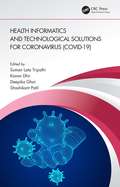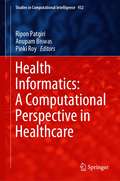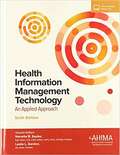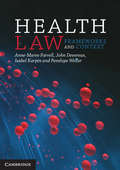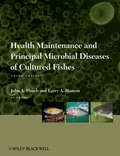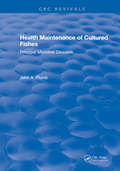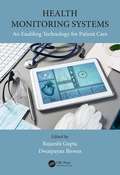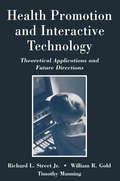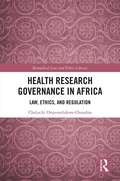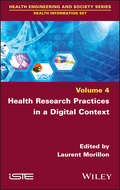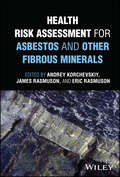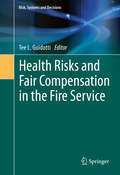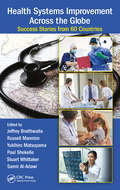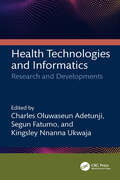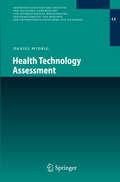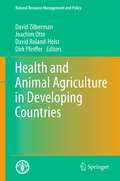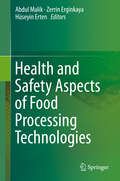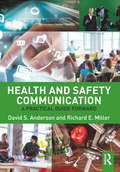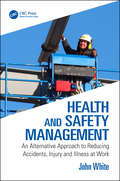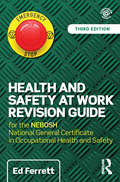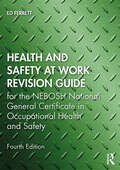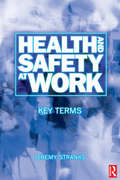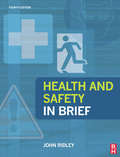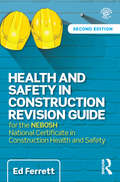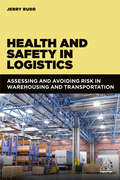- Table View
- List View
Health Informatics and Technological Solutions for Coronavirus (COVID-19)
by Suman Lata Tripathi Kanav Dhir Deepika Ghai Shashikant PatilThis reference text presents statistical information, causes and impacts of coronavirus on populations, economics, and environment. The text includes machine learning and deep learning techniques to understand exponential behavior as well as predicting the future reachability of the COVID-19 outbreak. It discusses important concepts including smart sensors for early stage diagnosis, diagnosis of COVID-19 using low power IoT-enabled systems, biomedical imaging and sensor fusion, and electronic solutions for diagnosis, monitoring, and treatment of diseases. Aimed at graduate students and professionals in the field of electrical engineering, electronics and communications engineering, biomedical engineering and nanomaterials, this book discusses fundamental aspects and latest research in the field of COVID-19 covers diagnostics techniques in detail provides overview of the symptoms, preventions, and treatments related to COVID-19 discusses android-based mobile applications helpful in spreading awareness of COVID-19
Health Informatics: A Computational Perspective in Healthcare (Studies in Computational Intelligence #932)
by Ripon Patgiri Anupam Biswas Pinki RoyThis book presents innovative research works to demonstrate the potential and the advancements of computing approaches to utilize healthcare centric and medical datasets in solving complex healthcare problems. Computing technique is one of the key technologies that are being currently used to perform medical diagnostics in the healthcare domain, thanks to the abundance of medical data being generated and collected. Nowadays, medical data is available in many different forms like MRI images, CT scan images, EHR data, test reports, histopathological data and doctor patient conversation data. This opens up huge opportunities for the application of computing techniques, to derive data-driven models that can be of very high utility, in terms of providing effective treatment to patients. Moreover, machine learning algorithms can uncover hidden patterns and relationships present in medical datasets, which are too complex to uncover, if a data-driven approach is not taken. With the help of computing systems, today, it is possible for researchers to predict an accurate medical diagnosis for new patients, using models built from previous patient data. Apart from automatic diagnostic tasks, computing techniques have also been applied in the process of drug discovery, by which a lot of time and money can be saved. Utilization of genomic data using various computing techniques is another emerging area, which may in fact be the key to fulfilling the dream of personalized medications. Medical prognostics is another area in which machine learning has shown great promise recently, where automatic prognostic models are being built that can predict the progress of the disease, as well as can suggest the potential treatment paths to get ahead of the disease progression.
Health Information Management Technology, 6e
by Nanette SaylesHealth Information Management Technology with Online Access: An Applied Approach 6th Edition
Health Law: Frameworks and Context (Oxford Studies In European Law)
by Isabel Karpin Farrell Anne-Maree John Devereux Penelope WellerHealth is a matter of fundamental importance in European societies, both as a human right in itself, and as a factor in a productive workforce and therefore a healthy economy. New health technologies promise improved quality of life for patients suffering from a range of diseases, and thepotential for the prevention of incidence of disease in the future. At the same time, new health technologies pose significant challenges for governments, particularly in relation to ensuring the technologies are safe, effective, and provide appropriate value for (public) money. To guard against the possible dangers arising from new health technologies, and to maximize the benefits, all European governments regulate their development, marketing, and public financing. In addition, several international institutions operating at European level, in particular the EuropeanUnion, the Council of Europe, and the European Patent Office, have become involved in the regulation of new health technologies. They have done so both through traditional 'command and control' legal measures, and through other regulatory mechanisms, including guidelines, soft law, 'steering'through redistribution of resources, and private or quasi-private regulation. This collection analyses European law and its relationships with new health technologies. It uses interdisciplinary insights, particularly from law but also drawing on regulation theory, and science and technology studies, to shed new light on some of the key defining features of the relationshipsand especially the roles of risk, rights, ethics, and markets. The collection explores the way in which European law's engagement with new health technologies is to be legitimized, and discusses the implications for biological or biomedical citizenship.
Health Maintenance and Principal Microbial Diseases of Cultured Fishes
by Larry A. Hanson John A. PlumbHealth Maintenance and Principal Microbial Diseases of Cultured Fishes, Third Edition is a thoroughly revised and updated version of the classic text. Building on the wealth of information presented in the previous edition, this new edition offers a major revision of the valuable health maintenance section, with new pathogens added throughout the book. Health Maintenance and Principal Microbial Diseases of Cultured Fishes, Third Edition focuses on maintaining fish health, illustrating how management can reduce the effects of disease. The text is divided into sections on health maintenance, viral diseases, and bacterial diseases, and covers a wide variety of commercially important species, including catfish, salmon, trout, sturgeon, and tilapia. This book is a valuable resource for professionals and students in the areas of aquaculture, aquatic health maintenance, pathobiology, and aquatic farm management.
Health Maintenance of Cultured Fishes: Principal Microbial Diseases
by John A. PlumbThe text concentrates on the infectious viral and bacterial diseases that are most prevalent in aquaculture. Although much information has been derived from North American studies, important diseaase problems from other parts of the world are included. Also, where applicable, the influence of the various diseases on wild populations has been included. This book is intended for students and scientists who are interested in health maintenance of aquatic animals, aquatic pathobiology, and infectious diseases of fin fish. Hopefully, it will be used as a text for beginning fish pathologists and as a reference source for those of broader experience.
Health Monitoring Systems: An Enabling Technology for Patient Care
by Rajarshi Gupta Dwaipayan BiswasRemote health monitoring using wearable sensors is an important research area involving several key steps: physiological parameter sensing and data acquisition, data analysis, data security, data transmission to caregivers, and clinical intervention, all of which play a significant role to form a closed loop system. Subject-specific behavioral and clinical traits, coupled with individual physiological differences, necessitate a personalized healthcare delivery model for around-the-clock monitoring within the home environment. Cardiovascular disease monitoring is an illustrative application domain where research has been instrumental in enabling a personalized closed-loop monitoring system, which has been showcased in this book. Health Monitoring Systems: An Enabling Technology for Patient Care provides a holistic overview of state-of-the-art monitoring systems facilitated by Internet of Things (IoT) technology. The book lists out the details on biomedical signal acquisition, processing, and data security, the fundamental building blocks towards an ambulatory health monitoring infrastructure. The fundamentals have been complimented with other relevant topics including applications which provide an in-depth view on remote health monitoring systems. Key Features: Presents examples of state-of-the-art health monitoring systems using IoT infrastructure Covers the full spectrum of physiological sensing, data acquisition, processing, and data security Provides relevant example applications demonstrating the benefits of technological advancements aiding disease prognosis This book serves as a beginner’s guide for engineering students of electrical and computer science, practicing engineers, researchers, and scientists who are interested in having an overview of pervasive health monitoring systems using body-worn sensors operating outside the hospital environment. It could also be recommended as a reference for a graduate or master’s level course on biomedical instrumentation and signal processing.
Health Promotion and Interactive Technology: Theoretical Applications and Future Directions (Routledge Communication Series)
by Richard L. Street William R. Gold Timothy ManningThis book's purpose is to offer various perspectives relating to the development, effectiveness, and implementation of interactive computing technology for health promotion--programs and interventions aimed at improving various health-related outcomes such as involvement in care, quality of life, adherence, disease management, healthy lifestyle, and more. Its coverage includes: *conceptual foundations for examining how characteristics of media, messages, and users relate to one another and how interactive media can effectively and appropriately promote health outcomes; *examinations of the development, utilization, and evaluation of specific computer applications for health promotion featuring discussions of the theoretical rationale for the program, the targeted audience, research on the program's effectiveness, and implications for future program development; and *analyses of critical issues such as potential benefits and limitations of technology on the delivery of care, institutional obstacles to the adoption of computing technology, and prospects for integrating information technology into the health system.
Health Research Governance in Africa: Law, Ethics, and Regulation (Biomedical Law and Ethics Library)
by Cheluchi Onyemelukwe-OnuobiaThe globalisation of research has resulted in the increased location of research involving humans in developing countries. Countries in Africa, along with China and India, have seen research grow significantly. With emerging infectious diseases, such as Ebola and Zika, emphasising the risk of public health crises throughout the world, a further increase in health research, including clinical research in developing countries, which are often the sites of these diseases, becomes inevitable. This growth raises questions about domestic regulation and the governance of health research. This book presents a comprehensive and systemic view of the regulation of research involving humans in African countries. It employs case studies from four countries in which research activities continue to rise, and which have taken steps to regulate health research activity: South Africa, Nigeria, Kenya, and Egypt. The book examines the historical and political contexts of these governance efforts. It describes the research context, some of the research taking place, and the current challenges. It also looks at the governance mechanisms, ranging from domestic ethical guidelines to legal frameworks, the strengthening of existing regulatory agencies to the role of professional regulatory bodies. The book analyses the adequacy of current governance arrangements within African countries, and puts forward recommendations to improve the emerging governance systems for health research in African and other developing countries. It book will be a valuable resource for academics, researchers, practitioners and policy-makers working in the areas of health research, biomedical ethics, health law and regulation in developing countries.
Health Research Practices in a Digital Context
by Laurent MorillonThe current “generalized digitization” of society is influencing the health environment, healthcare organizations as well as actors. In this context, human and social sciences deconstruct, nuance and sometimes even challenge certain preconceived ideas and/or dominant discourses. In this book, researchers of four nationalities and three different disciplines have agreed to open the “black box” of their work. They display their scientific practices from the perspective of epistemology, ethics and methodology. They present and analyze their values and postulates but, also, what may have influenced the project, the definition of the object and objectives, as well as their approaches. In a contextual way, the first part presents some changes in environments and infocommunicational practices related to digital health. The second part opens space to reflect on ethics and deontology. Finally, postulating that scientific fact is not an essence but the result of a process, the last part discusses the methods implemented, which may be different from those initially envisaged. This book is dedicated to the researchers and postgraduate students in the human and social sciences as well as the health practitioners likely to collaborate with them.
Health Risk Assessment for Asbestos and Other Fibrous Minerals
by Andrey Korchevskiy James Rasmuson Eric RasmusonEvaluates the risks and human health impacts of asbestos and other fibrous minerals Despite continuous efforts to eliminate asbestos from commercial use, it remains a serious occupational and environmental hazard. Health Risk Assessment for Asbestos and Other Fibrous Minerals provides a rigorous discussion of risk assessment methodology for elongate mineral particles, covering basics, theory, models, and practical applications, enabling readers to participate in carrying out efficient and informed health risk assessments, to estimate potential adverse effects for exposed populations, and to determine the acceptability of risks at a given level of exposure. Coverage includes: Mineralogy, health effects, pathology, exposure assessment, modeling, and characterization of risks for asbestos and similar toxic materialsNecessary integration of epidemiology, toxicology, industrial hygiene, and environmental health expertise when performing a health risk assessmentEmerging and not-well-known hazards, e.g. erionite and other naturally occurring fibrous mineralsContributions by Garry Burdett, Bruce Case, Lucy Darnton, Daniel Hall, Arseniy Korchevskiy, Brooke Mossman, Cassidy Strode, Robert Strode, and Ann WylieCase studies and examples of risk calculations Health Risk Assessment for Asbestos and Other Fibrous Minerals is a highly practical reference on the subject for occupational and public health professionals, industry and government regulators, industrial hygienists, and risk assessors, along with epidemiologists, biostatisticians, toxicologists, and other scientific professionals.
Health Risks and Fair Compensation in the Fire Service
by Tee L. GuidottiThis book is an overview of the hazards of firefighting, the health risks of exposure to combustion products that characterize firefighting, the science behind interpreting these risks for purposes of identifying diseases as work-related, and the legal and policy implications of adopting legislated "presumption" for purposes of compensation. The emphasis of the book will be on the risk of cancer, cardiovascular disease, traumatic hazards, and disabling psychosocial adjustment following major incidents. Several new studies have appeared recently, including the largest study of firefighters ever done, by the National Institute of Occupational Health and Safety (NIOSH). They evidence supports the conclusion that firefighters face significant occupational health risks in addition to the obviously severe safety hazards.
Health Systems Improvement Across the Globe: Success Stories from 60 Countries
by Jeffrey Braithwaite Russell Mannion Yukihiro Matsuyama Paul Shekelle Stuart Whittaker Samir Al-AdawiFollowing on from 2015’s Healthcare Reform, Quality and Safety: Perspectives, Participants, Partnerships and Prospects in 30 Countries, this book encompasses a global perspective on healthcare while shifting the focus from reform to showcasing success stories of healthcare systems worldwide. It provides explanations of why various facets of healthcare systems work well in different contexts and offers the reader alternative models for consideration. The book features contributions from 60 countries, going much further than the common practice of focusing on affluent Western nations, to provide a comprehensive exploration of the success of healthcare systems globally. The majority of literature on health-sector improvement attempts to address the problems within systems, relating the errors that can and do occur, for example, and offering solutions and preventative strategies. This book of country case studies will approach the enhancement of health systems, patient safety and the quality of care in a new and innovative way, comprehensively surveying and synthesizing the success stories of healthcare systems around the world, utilizing Hollnagel’s Safety-II approach to acknowledge the importance of exploring what goes right, what works well, and why it works. These success stories may include reference to macro, meso or micro levels of healthcare systems, various sectors (e.g., aged care, acute care or primary care), or specific programs or projects. Health System Improvement Across the Globe: Success Stories from 60 Countries is unprecedented in terms of both reach and positive emphasis, and as such will be instrumental in changing ways of thinking about and guiding health-sector improvement.
Health Technologies and Informatics: Research and Developments
by Charles Oluwaseun Adetunji Segun Fatumo Kingsley Nnanna UkwajaHealth Technologies and Informatics: Research and Developments provides a comprehensive overview of mobile health applications, biodata management and analytics, medical imaging, personalized and public health systems, and biosignal processing.With a focus on medical informatics, which has been identified as a necessity relating to health challenges relevant to the current pandemic, this book highlights engineering applications and methodologies involved in data evaluations. Detailed information is provided on diseases which could be monitored and necessary intervention for the treatment of these diseases or medical conditions.Features: Provides recent advances on research and developments in the field of biomedical and health informatics Introduces topics such as mobile messaging, objectified information exchange, SmartCare, IoT-driven healthcare, cybersecurity issues, AI-enhanced healthcare, and so forth Covers novel engineering applications and methodologies involved in the pertinent data evaluations Includes dedicated chapters on machine learning in management and mitigation of COVID-19 Explores the role of extended reality in health care including virtual, augmented, and mixed reality This book is aimed at researchers and graduate students in biomedical and computer engineering.
Health Technology Assessment
by Daniel WidrigDas Buch befasst sich mit den weltweit laufenden Bemühungen, Health Technology Assessment (HTA) im Gesundheitswesen zu etablieren. Der Autor stellt die historische Entwicklung von HTA dar und präsentiert eine sorgfältige Definition des Begriffes. Dazu gehört eine kritische Auseinandersetzung mit den Grundprinzipien von HTA sowie der damit verknüpften rechtlichen Aspekte. Neben Aufbau und Unterarten von HTAs wird zudem ein Lösungsansatz vorgestellt, um HTA-Arten klar voneinander abzugrenzen. Ein Grossteil der Arbeit umfasst eine zugängliche Einführung in die an HTA beteiligten Disziplinen. Zudem werden ausgewählte nationale und internationale HTA-Agenturen porträtiert. Überlegungen zur ,,Best-Practice" und ein dreistufiger Lösungsansatz zur Implementation von HTA runden das Werk ab. Es ist das erste Werk, dass sich in so ganzheitlicher Weise mit der Thematik auseinandersetzt.
Health and Animal Agriculture in Developing Countries
by David Zilberman Dirk Pfeiffer Joachim Otte David Roland-HolstThis book provides an overview of the state of animal agriculture and present methodologies and proposals to develop policies that result in sustainable and profitable animal production that will protect human and environmental health, enhance livelihood of smallholders and meet consumer needs. The book combines lessons of the past, factual foundation to understand the present, analytical tools to design and improve policies, case studies that provide both empirical grounding and applications of some of the strategies suggested in this book, and finally, a proposal for the way forward.
Health and Safety Aspects of Food Processing Technologies
by Abdul Malik Zerrin Erginkaya Hüseyin ErtenFood processing is expected to affect content, activity and bioavailability of nutrients; the health-promoting capacity of food products depends on their processing history. Traditional technologies, such as the use of antimicrobials and thermal processing, are efficient in increasing nutritional value to an extent, though they may not be effective at addressing food safety, particularly when it comes to maintaining the food's molecular structure. Modern food processing plants improve the quality of life for people with allergies, diabetics, and others who cannot consume some common food elements. Food processing can also add extra nutrients, such as vitamins. Processed foods are often less susceptible to early spoilage than fresh foods and are better suited for long-distance transportation from the source to the consumer. However, food processing can also decrease the nutritional value of foods and introduce hazards not encountered with naturally occurring products. Processed foods often include food additives, such as flavourings and texture-enhancing agents, which may have little or no nutritive value, and may in fact be unhealthy.This book deals with the subject of food processing in a unique way, providing an overview not only of current techniques in food processing and preservation (i.e., dairy, meat, cereal, vegetables, fruits and juice processing, etc.) but also the health and safety aspects: food technologies that improve nutritional quality of foods, functional foods, and nanotechnology in the food and agriculture industry. The text also looks into the future by defining current bottlenecks and future research goals. This work will serve as a ready reference for the subject matter to students and researchers alike.
Health and Safety Communication: A Practical Guide Forward
by Richard E. Miller David S. AndersonHealth and Safety Communication: A Practical Guide Forward is an easy introduction to the principles and practice of health and safety communications, providing all you need to know to design and implement communications efforts on a wide range of health and safety topics and issues. Whether you're a student grappling with a health communications course or a professional wishing to learn how to communicate health and safety messages effectively to a range of audiences using a variety of communications media, Health and Safety Communication is all you'll need. This book incorporates two broad sections: the grounding and the applications. The model articulates a planning approach for designing, implementing and reviewing a range of communications approaches. The applications segment specifies numerous approaches, including workshops, print materials, campaigns, the media, public speaking and social media that can be used to convey what the health and safety specialist wants the audience to "know, feel and do" as a result of engagement with the communications approach. Health and Safety Communication blends sound foundations with practical strategies for health and safety communication so that messages can be communicated more effectively; after all, for changes to occur, the message must be received and respected. Unique features of this book include a wide range of approaches and strategies, with numerous examples and tips provided throughout. "Messages from the field" incorporate examples and samples from over 30 individuals and organizations, offering their insights and suggestions. The applied approach of this definitive guide is designed to enhance the competence and confidence of those currently in health or safety arenas, as well as those seeking to incorporate health or safety messages in other settings such as businesses or communities.
Health and Safety Management: An Alternative Approach to Reducing Accidents, Injury and Illness at Work
by John WhiteAt a time when our knowledge and understanding of health and safety at work is at its highest, statistics show that ongoing improvements in accident rates and time taken off work due to injury and ill-health are stagnating. Alongside the fact that around 80% of accidents can be attributed to human error, there is also increasing concern that modern-world issues of mental and physical wellbeing are undermining recent gains made ensuring the safety of people at work. <P><P>By applying the principles of marginal gain and using lessons drawn from the high-risk world of outdoor adventure and high level sport, this book provides a variety of practical solutions and seeks to reduce the incidence of human error in the workplace and the number of accidents and near-misses. The concept of Free Thinking Hazard Identification is introduced alongside the importance of managing changing circumstances and minimising the frequently underestimated risk to experienced workers. A range of practical recommendations are also made to help reduce time taken off work due to injury or ill-health, through managing fitness, diet and health and paying attention to mental wellbeing.
Health and Safety at Work Revision Guide: for the NEBOSH National General Certificate in Occupational Health and Safety
by Ed Dr FerrettThis companion to the bestselling Introduction to Health and Safety at Work is an essential revision aid for students preparing for their written assessments on the NEBOSH National General Certificate in Occupational Health and Safety. Fully updated to the latest NEBOSH National General Certificate specifications (April 2015), the revision guide provides complete coverage of the syllabus in bite-sized chunks, helping readers to learn and memorise the most important topics. Throughout the book, the guide refers back to the Introduction to Health and Safety at Work textbook, helping students to consolidate their learning. · Small and portable making it ideal for use anywhere: at home, in the classroom or on the move · Suggests useful tips on study and examination technique · Includes practice questions and answers based on NEBOSH exam questions · Everything you need for productive revision in one handy reference The Health and Safety at Work Revision Guide, written by the renowned health and safety author and former NEBOSH Vice Chairman Ed Ferrett, will be an invaluable tool for students as they prepare for their NEBOSH exam and for their subsequent health and safety work.
Health and Safety at Work Revision Guide: for the NEBOSH National General Certificate in Occupational Health and Safety
by Ed FerrettThis companion to the bestselling Introduction to Health and Safety at Work will help you prepare for the written assessments on the NEBOSH National General Certificate in Occupational Health and Safety (2019 specification). It provides complete coverage of the syllabus in bite-sized chunks and will help you learn and memorise the most important areas, with links provided back to the main Introduction to Health and Safety at Work text to help you consolidate your learning. ● Small and portable, making it ideal for use anywhere: at home, in the classroom or on the move ● Includes specimen questions and answers based on recent examination papers ● Everything you need for productive revision in one handy reference source This revision guide is written by an experienced lecturer and former Vice Chairman of NEBOSH, who has spent many years helping students become accredited by NEBOSH.
Health and Safety at Work: Key Terms
by Jeremy StranksHealth and Safety at Work: Key Terms provides instant information to readers on a range of key terms used in health and safety at work. The book, produced in A-Z format, incorporates the principal legal, technical and practical terms derived from statutes, regulations, approved codes, case law and other appropriate publications. As such, it will be of particular use to health and safety practitioners, those studying for degrees in occupational health and safety and courses run by NEBOSH, and those engaged in enforcement activities, such as Health and Safety Executive inspectors, environmental health officers and fire protection officers.The key terms referenced and explained include: accident statistics; absolute duties; distance guard; noise-induced hearing loss; oxidising classifications; relevant statutory provisions.
Health and Safety in Brief (Made Simple Bks.)
by John RidleyIn plain English, John Ridley guides the reader through Health and Safety legislation and explains how to comply with it in practical terms. The text is clearly laid out, distinguishing between bulleted summaries of legislative requirements and the author's advice and commentary.By condensing the fundamental contents of the author's acclaimed Safety at Work into a practical and affordable volume, Health and Safety in Brief has established itself as a valuable handbook for safety representatives and managers, as well as an essential revision aid for students on introductory health & safety and general management courses such as: * NEBOSH National Certificate and Diploma in Occupational Safety and Health* IOSH Managing Safely* CIEH Advanced Certificate in Health & Safety in the Workplace * British Safety Council Level 3 Certificate in Occupational Safety and Health * NVQs in Occupational Safety and Health * Chartered Management Institute's Level 5 Diploma in ManagementNew in this edition:* Completely revised coverage of fire safety in line with Regulatory Reform (Fire Safety) Order* Construction safety incorporates new Construction (Design and Management) Regulations 2007 and new Working at Heights Regulations* Coverage of changes in employment law, including age discrimination and working time* More on the effects of the Woolf Report
Health and Safety in Construction Revision Guide: for the NEBOSH National Certificate in Construction Health and Safety
by Ed FerrettThis companion to the bestselling Introduction to Health and Safety in Construction is an essential revision aid for students preparing for their written assessments on the NEBOSH National Certificate in Construction Health and Safety. Fully updated to the April 2015 specification, the revision guide provides complete coverage of the syllabus in bite-sized chunks, helping readers to learn and memorise the most important topics. Throughout the book, the guide links back to the Introduction to Health and Safety in Construction textbook, helping students to consolidate their learning. · Small and portable making it ideal for use anywhere: at home, in the classroom or on the move · Suggests useful tips on study and examination technique · Includes practice questions and answers based on NEBOSH exam questions · Everything you need for productive revision in one handy reference The Health and Safety in Construction Revision Guide, written by the renowned health and safety author and former NEBOSH Vice Chairman Ed Ferrett, will be an invaluable tool for students as they prepare for their NEBOSH exam and for their subsequent health and safety work.
Health and Safety in Logistics: Assessing and Avoiding Risk in Warehousing and Transportation
by Jerry RuddLogistics is a complex industry that exposes employees to a whole variety of risks. These include not only accidents on the road and deaths and injuries resulting from unsafe use of forklifts, but also the consequences of poor fire safety, long-term health risks due to poor manual handling technique and problems relating to mental health. Many thousands of incidents are recorded every year. This book examines each aspect of health and safety in turn, with a focus on warehousing and transportation.Health and Safety in Logisticsinforms managers about potential hazards found in the industry and explains in detail how they can make the workplace as safe as possible.
